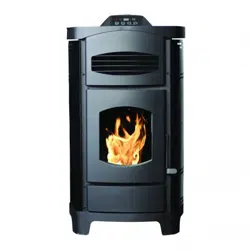Loading ...
Loading ...
Loading ...

-9-
• Manual mode operates according to the 5 set levels of feed
on the bar graph from heat range “1” to heat range “5”.
• T-Stat mode works as follows:
• The stove has a built in Thermostat into the controls of the
appliance. The temperature sensor for the T-Stat is located on
the back of the stove behind the display board.
• Once the stove has gone into run mode the stove can be
switch into T-Stat mode.
• The Up and Down Level / Temp Arrow buttons are used to
change the desired set-point temperature. Once the desired
temperature is reached the two digit display will ash for four
seconds and reset to the actual room temperature.
• Once the stove reaches within 3°F of the desired temperature
set point, it returns to the heat range that the stove was set on before it was switched to T-Stat mode (if the
stove was running on heat range “5” when switched to T-stat mode when it gets within 3°F of the set point it
will return to heat range “5”).
• Once the stove reaches the desired set-point, the stove will drop to heat range “1”.
• When room temperature drops below desired set-point the stove will ramp back up until it reaches the desired
temperature.
Level / Temp
Manual
T-Stat
Operation
• Do not use chemicals or uids to start the re - never use gasoline, gasoline-type lantern fuel, kerosene, charcoal
lighter uid, or similar liquids to start or “freshen up” a re in this stove. Keep all such liquids well away from the
stove while it is in use.
• Hot while in operation. Keep children, clothing and furniture away. Contact may cause skin burns.
This heater is designed to burn only PFI Premium grade pellets. DO NOT BURN:
1. Garbage;
2. Lawn clippings or yard waste;
3. Materials containing rubber, including tires;
4. Materials containing plastic;
5. Waste petroleum products, paints or paint thinners,
or asphalt products;
6. Materials containing asbestos;
7. Construction or demolition debris;
8. Railroad ties or pressure-treated wood;
9. Manure or animal remains;
10. Salt water driftwood or other previously salt water
saturated materials;
11. Unseasoned wood; or
12. Paper products, cardboard, plywood, or
particleboard. The prohibition against burning these
materials does not prohibit the use of re starters
made from paper, cardboard, saw dust, wax and
similar substances for the purpose of starting a re in
an affected wood heater.
Burning these materials may result in release of toxic fumes or render the heater ineffective and cause smoke.
PROPER FUEL
This stove is approved for burning pelletized wood fuel only ! Factory-approved pellets are those 1/4” or 5/16”
in diameter and not over 1” long. Longer or thicker pellets sometimes bridge the auger ights, which prevents
proper pellet feed. Burning wood in forms other than pellets is not permitted. It will violate the building codes for
which the stove has been approved and will void all warranties. The design incorporates automatic feed of the
pellet fuel into the re at a carefully prescribed rate. Any additional fuel introduced by hand will not increase
heat output but may seriously impair the stoves performance by generating considerable smoke. Do not burn
wet pellets. The stove’s performance depends heavily on the quality of your pellet fuel. Avoid pellet brands that
display these characteristics:
1. Excess Fines – “Fines” is a term describing crushed pellets or loose material that looks like sawdust or sand.
Pellets can be screened before being placed in hopper to remove most nes.
2. Binders – Some pellets are produced with materials to hold the together, or “bind” them.
3. High ash content – Poor quality pellets will often create smoke and dirty glass. They will create a need for
more frequent maintenance. You will have to empty the burn pot plus vacuum the entire system more often.
Poor quality pellets could damage the auger. We cannot accept responsibility for damage due to poor
quality pellet.
Loading ...
Loading ...
Loading ...
